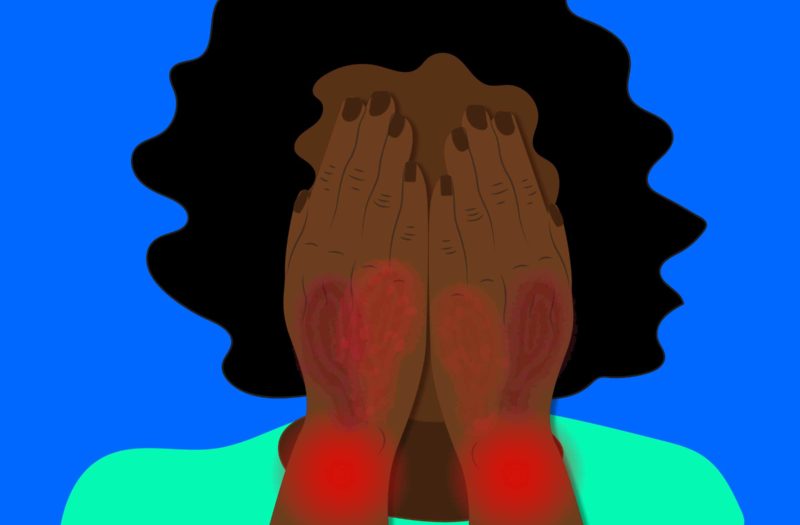Key Takeaways
- Many people with PsA do not meet standardized targets for minimal or low disease activity.
- Those who reach strict treatment targets fare better overall compared to those who don’t meet these targets, but that doesn’t mean they’re symptom-free: Some ongoing joint and/or skin problems remain common.
- Patients and providers often have different ideas about what constitutes effective treatment.
If you have psoriatic arthritis (PsA), you’ve likely heard that starting treatment early and sticking with it is crucial for controlling your symptoms as well as preventing the disease from worsening. That’s true, but it’s not as simple as filling a prescription and taking the medication as directed.
PsA is an inflammatory disease that merges joint symptoms like stiffness and swelling with skin and/or nail psoriasis. It’s chronic, so once you have it you will always have it, even if you manage to reach remission. For many people, low disease activity is a more realistic goal.
In recent years, experts have become to embrace using the “treat to target” approach for people with PsA. Treat to target is a concept that’s widely employed in other inflammatory diseases such as rheumatoid arthritis (RA); it entails treating the condition as aggressively as needed to reach a pre-determined goal, which is usually defined as low disease activity or remission.
Treat to target has only recently been employed for use in people with PsA, so experts are still sorting out how to best use it. Currently, doctors using this strategy for their patients might aim for low or minimal disease activity as measured by several different tools. Those include the minimal disease activity (MDA) metric, Disease Activity Index in PsA (DAPSA), and clinical DAPSA (cDAPSA).
But has this approach been working? And are people with PsA happy with the results? To find to out, researchers from the University of Oxford in the UK conducted a systematic research review aimed at finding out whether those who were assessed against treatment targets are indeed reaching remission or whether they are experiencing ongoing symptoms.
To conduct the research review, which was published in Rheumatology and Therapy, the authors culled more than 2,300 records from 42 earlier publications. Participants in these publications had been assessed using either MDA or DAPSA.
They determined that “despite treatment, a large proportion of people with PsA may not reach treatment targets and consequently face substantial disease.” And while those who did meet targets such as MDA tended to have fewer ongoing symptoms, some issues were still persistent: A significant number of people who were officially in remission (or close to it) still complained of swollen joints, pain, skin problems, and other issues that interfered with the quality of their life.
“Persistence of patient-reported symptoms, even among patients in [very low disease activity] or [remission], indicates that achieving stringent targets may still not result in satisfactory resolution of disease and acceptable disease impact from the patient’s perspective,” the authors wrote.
“Overall, the findings of this study highlight the need for further effective treatments and for continued refinement of strategies to reduce residual disease, both in patients aiming to achieve treatment targets and in those who have achieved them,” they concluded.
What This Means for You
Since it’s possible that you can have low or even minimal disease activity and still have joint stiffness, scaly skin patches, and fatigue, it’s important to speak up if your symptoms are interfering with your quality of life.
You and your doctor will need to work closely together and may need to continually tweak your medication regimen in order to achieve what’s most important to you. Make sure you and your doctor are on the same page. Discuss your specific treatment goals so your provider understands what’s most important to you.
Found This Study Interesting? Get Involved
If you are diagnosed with arthritis or another musculoskeletal condition, we encourage you to participate in future studies by joining CreakyJoints’ patient research registry, ArthritisPower. ArthritisPower is the first-ever patient-led, patient-centered research registry for joint, bone, and inflammatory skin conditions. Learn more and sign up here.
Coates, L. et al. “Achieving Minimal Disease Activity in Psoriatic Arthritis Predicts Meaningful Improvements in Patients’ Health-Related Quality of Life and Productivity.” BMC Rheumatology. doi: https://doi.org/10.1186/s41927-018-0030-y.
Coates, L et al. “Residual Disease Associated with Suboptimal Treatment Response in Patients with Psoriatic Arthritis: A Systematic Review of Real-World Evidence.” Rheumatology and Therapy. April 12, 2022. doi: https://doi.org/10.1007/s40744-022-00443-y.
Gazitt, T. et al. “Implementation of the Treat-to-Target Concept in Evaluation of Psoriatic Arthritis Patients.” Journal of Clinical Medicine. doi: https://doi.org/10.3390/jcm10235659.






